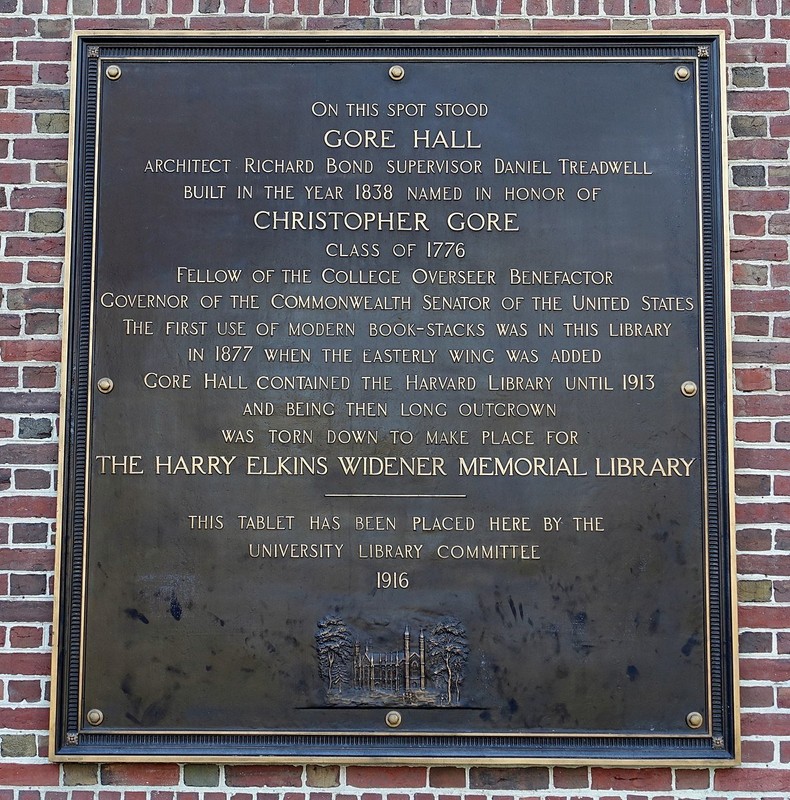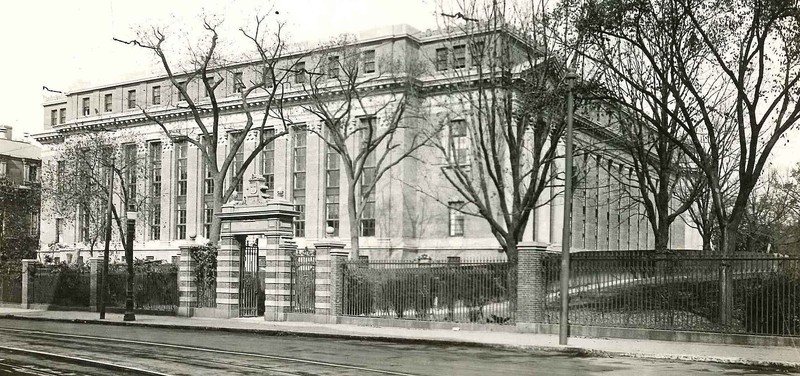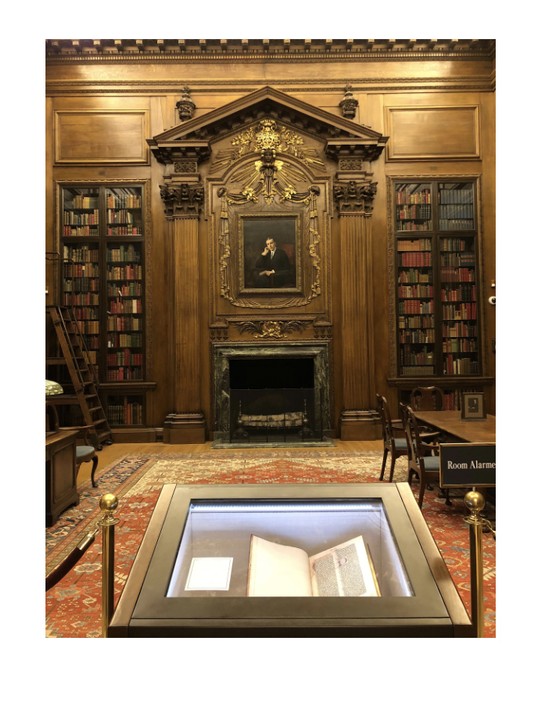Widener Library
Introduction
Author-Uploaded Audio
Listen to a narration of this entry's description by Victoria Endres.
Text-to-speech Audio
Images
Plaque that sits outside Widener commemorating Gore Hall.

Widener after construction finished in 1915.

2018 view inside the Harry Elkins Widener Memorial Reading Room. Note the Gutenberg Bible in the foreground and the portrait of Harry Elkins Widener above the mantle.

Backstory and Context
Author-Uploaded Audio
Listen to a narration of this entry's description by Victoria Endres.
Text-to-speech Audio
The story of Widener Library’s namesake and subsequent dedication in his honor are perhaps most significant in the library’s construction. Harry Elkins Widener, an avid book collector and Harvard graduate, died in the shipwreck of the RMS Titanic. His mother, who survived the incident, decided to gift a library in his honor using her and her family’s considerable wealth. Widener’s love for books played an important role in Harvard’s ability to build an expansive library network to this day [9].
One portion of history — both Harvard’s history and the general history of libraries — that has been notably erased by the construction of Widener Library is its predecessor, Gore Hall. This original repository was named after Christopher Gore, Harvard class of 1776, who was a governor and senator representing Massachusetts. Gore Hall was taken down in 1913 to make way for Widener Library, which afforded much more space to Harvard’s growing book collection due to its layers of underground stacks [6].
Eleanor Elkins Widener’s gift and the replacement of Gore Hall have both affected both the scope of Harvard’s collections and the physical space of the library in the ensuing decades. By greatly expanding Harvard’s ability to store books, Widener enabled university librarians to expand collections and push for the creation of even more space for books, such as Lamont Library and the Harvard Depository. Additionally, the stipulations of Widener’s gift maintained that the physical structure of the new library could not be altered in any way, ensuring that the library would not be upended as Gore Hall was when it ran out of space in its stacks; instead, it expanded downward by adding multiple subterranean levels [4].
Burglaries, successful and unsuccessful, have had a significant impact on the library’s history. In 1931, Joel C. Williams was discovered to have stolen approximately $15,000 worth of books, 1,804 of which were bought back by library officials feigning being on business as book-buyers [7]. In 1969, Vido K. Aras of Dorchester attempted to lift a copy of the Gutenberg Bible by climbing up a rope and out a window; however, he fell and suffered significant injuries before being discovered in the morning [5]. In 1990, a former Widener staffer was “charged with stealing or mutilating hundreds of books on church history and linguistics, … making bomb threats against Northeastern University, and … attempted extortion” [10]. One further major incident occurred in 2001; over $10,000 worth of material from the French Revolution was stolen [8].
According to its website, Widener was recently renovated from 1999 to 2004, to “ensure the long-term preservation and security of collections, and to increase user space” [2]. In the five year renovations, one of the biggest projects was to create a large reading room on the second floor in which students could study. Creating the reading room involved clearing out a large room on the second floor, known as Loker, and replacing reference desks with appropriate seating and tables--dedicated solely to quiet student work [11].
The second major shift from the 20th century to the 21st century was a digitization of Harvard’s book collection, created to accommodate the growing collection and shrinking space to put everything. This digitized database is known as HOLLIS, and allows students to search for books, journal articles, photos, and other things found in the libraries [12].
Today, the library serves as a place for students to study, collaborate, and use the expanding collection of books. According to its website, anyone with a Harvard ID or a “Harvard Special Borrower Card” can access the library, and ID holders can bring up to four guests, if those guests show proper identification [2].
Sources
[1] “Harry Elkins Widener Collection.” Harvard Library. Accessed November 12, 2018. https://library.harvard.edu/collections/harry-elkins-widener-collection.
[2] “Widener Library.” Harvard Library. Accessed November 13, 2018. https://library.harvard.edu/libraries/widener.
[3] “Welcome, Harvard Visitors | Access Services | Harvard Library.” Accessed November 12, 2018. https://emeritus.library.harvard.edu/access-services/visitors.
[4] Battles, Matthew. Library: An Unquiet History. W. W. Norton & Company, 2004.
[5] “Burglar Slips as He Tries to Remove Gutenberg Bible From Widener Library | News | The Harvard Crimson.” Accessed November 6, 2018. https://www.thecrimson.com/article/1969/9/18/burglar-slips-as-he-tries-to/.
[6] Harvard University, Library. Gore Hall: The Library of Harvard College, 1838-1913. Harvard University Press, 1917. http://hdl.handle.net/2027/hvd.32044011485505.
[7]“INDICT BOOK THIEF ON TWENTY COUNTS | News | The Harvard Crimson.” Accessed November 6, 2018. https://www.thecrimson.com/article/1931/11/4/indict-book-thief-on-twenty-counts/.
[8] “Late Bulletins.” Library Journal 126, no. 9 (May 15, 2001): 11.
[9] Norton, A. Edward. “A Remembrance of Harry Elkins Widener.” The Atlantic Monthly, 1918.
[10] “The Slasher.” Accessed November 6, 2018. http://harvardmagazine.com/1997/03/biblio.slasher.html.
[11] “Widener Reading Room Reopens | News | The Harvard Crimson.” Accessed November 6, 2018. http://www.thecrimson.com/article/2004/5/3/widener-reading-room-reopens-the-penultimate/.
[12]“HOLLIS.” Harvard Library. Accessed November 13, 2018.
https://library.harvard.edu/services-tools/hollis
https://commons.wikimedia.org/wiki/File:Gore_Hall_plaque,_Harvard_College_-_Cambridge,_Massachusetts_-_DSC05562.JPG
https://pt.wikipedia.org/wiki/Ficheiro:HarvardUniversity_WidenerLibrary_MassachusettsAvenueEntrance_c1915_cropped.jpeg
Abby Scholer
